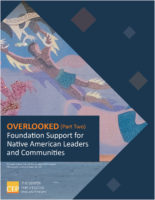Despite the significant challenges facing Native American people, most foundations continue to overlook nonprofits that serve Native American communities.
Over the past two years, Native American communities have been disproportionately impacted by the COVID-19 pandemic. Native Americans have been hospitalized and have died from COVID-19 at higher rates than any other racial/ethnic group in the United States. Between April 2020 and June 2021, one in every 168 Native American children in the United States lost a caregiver due to the pandemic.
These extremely high death rates, especially among community elders, also threaten the progress made in preserving Native languages. Further, these hospitalization and death rates are likely significantly higher than the data show, because many states do not consistently track data on Native Americans. Compounding the health-related impacts of COVID-19, tribal governments and Native American economies have been devastated by the pandemic.








